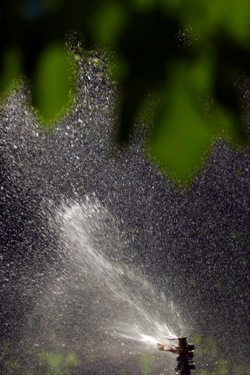CROP IRRIGATION
Crops, like humans need water in order to live. Irrigation has been a practice in growing crops since time immemorial and like other practices; it has also evolved over time to provide crop growers with different ways to water their fields.
 Irrigation is the term used to refer an artificial method of wetting lands or soil thereby assisting crops during their growth stages or their entire lifespan (depending on how reliant the crops are on water). The most common water sources are those found from underground springs, rivers, reservoirs, wells and drainage water. Irrigation has been one of the most important uses of water which comes next to humans’ and animals’ large dependency on water. In fact, the world’s water usage on irrigation comprises 60% of the total consumption.
Irrigation is the term used to refer an artificial method of wetting lands or soil thereby assisting crops during their growth stages or their entire lifespan (depending on how reliant the crops are on water). The most common water sources are those found from underground springs, rivers, reservoirs, wells and drainage water. Irrigation has been one of the most important uses of water which comes next to humans’ and animals’ large dependency on water. In fact, the world’s water usage on irrigation comprises 60% of the total consumption.
Irrigation as a process has been around for centuries when ancient peoples used manual irrigation. However, as  technology has developed over the years to continuously change our everyday lives from manual to automatic, newer methods of irrigating crops were also introduced, particularly for large scale cropping.
METHODS FOR IRRIGATING CROPS WITH WATER
Flood Irrigation
This by far is the most commonly used method of irrigating agricultural crops. You can categorize this method of irrigation as the advanced form of manual irrigation. It is used where larger area require irrigation and where labour and water distribution is restricted.
As the name suggests, flood irrigation supplies huge crop fields with massive volumes of water which will eventually flood the area. This is done through a pumping system that delivers water from a source to the field and lets it flow on the ground. Probably the reason why this is the most commonly used form of irrigation is because it is the cheapest and simplest form. The downside for the flooding method however, is that not all the water that flows into the field is  absorbed by the soil because some run off occurs.
The limitations of this method have driven farmers to find other ways to minimise water wastage from flooding. Modified flooding irrigation methods includes Levelling of Fields, wherein farmers will have to create toil or scrape the field and have it flattened to ensure that the water which will be flowing into the field will be evenly distributed. Another form of modified flood irrigation is the Surge Flooding where water is released on to the field at specific intervals.
Drip Irrigation
This type of irrigation uses pipes which are placed in rows along with the crops. Usually they are placed on the crops’ root line so that water is easily absorbed. The pipes that are used for drip irrigation have holes in them where water runs through.
Spray/Sprinkler Irrigation
The most modern way of water irrigation for crops is spray irrigation. Large scale crops use this type of irrigation system and involves the use of expensive machinery which means that it is pretty costly.
The most common type of Sprinkler irrigation is the Centre Pivot. This type of sprinkler irrigation basically makes use the concept of the regular hose you use in your homes. A certain point in the field serves as the point of origin (well) from which the system sources the water. As soon as the pumping system is turned on, the water will run through the tubes to spray water into the fields.
Traditional/Manual Irrigation
For small-scale farming, manual irrigation or the traditional way of using buckets to apply water to crops may be chosen. However, this type of irrigation, although inexpensive will require more human labour compared to other types.